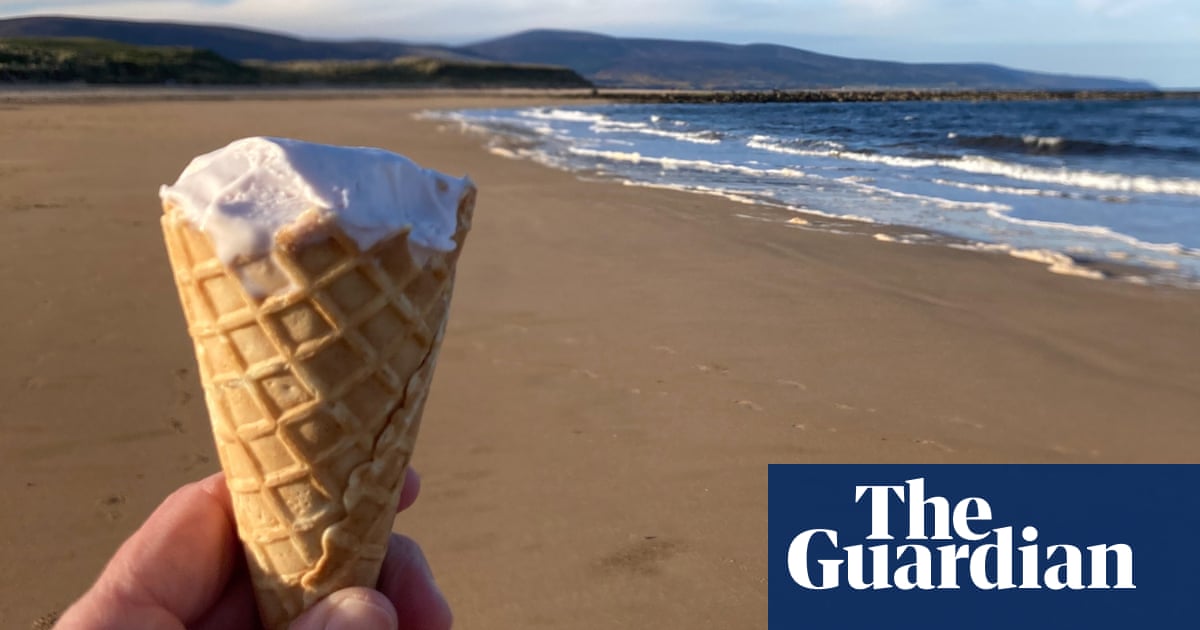
Iwas weaving through an underwater forest, russet strands of seaweed billowing around me like mermaids’ hair. As we snorkelled, the water was at times shallow enough that my fins scraped the sand; at others, the kelp-smothered rocks seemed to drop away, leaving the seabed out of reach. A flicker of movement in the corner of my eye had me spinning around to find my guide, Rhionna, pointing to a small, crimson-red sea anemone on a dark rock, its tentacles quivering in the current.
Afterwards, we sat in the shallows and peeled off our fins, moving back and forth with the motion of the waves. A cluster of bemused campervanners were watching from above. And who could blame them? Like them, I’d never associated the North Sea – least of all far northern Scotland – with snorkelling. “How was it?” one asked once I’d dripped my way up to the car park. “Absolutely brilliant,” I said, my cheeks strained from smiling.
I was in the village of Brora, on the east coast of Sutherland, almost 60 miles north of Inverness. The A9 – here part of the North Coast 500 – cuts right through it, past a cluster of shops and neat grey-stone workers’ cottages (a testament to Brora’s years of coal mining). With no glimpse of the beach from the road when you travel north, it’s easy to whiz past – indeed, if you have heard of Brora, it’s probably because of its golf course or distillery.
Snorkelling is just one of the watersports offered by Rhionna at Sutherland Adventure Company. I began the day with her at Loch Brora, four miles inland, for my first attempt at paddleboarding. “If conditions were right, we could have paddled downriver to the beach and snorkelled off our boards,” Rhionna said with a rueful smile, watching the wind ripple the clear, peaty waters of the loch, “but this is the Highlands, so you have to be prepared to adapt your plans.”
Still, it was no hardship to be out on the loch, under a cornflower-blue sky and surrounded by gentle hills that still bear the scars of the Highland clearances. I’d been convinced I’d make a fool of myself on the water, but Rhionna was an excellent teacher and it wasn’t long before I was confidently paddling around the island in the middle of the loch, which had seemed impossibly far away when we first started.
There are just a handful of places – largely self-catering – to stay in and around the village, which made my choice of the graceful Royal Marine hotel, next door to the golf course and opposite the harbour, feel like the standout option. “We have it all here – water sports, golf, fishing, hiking, biking, whisky, beaches,” said Billy McKechnie, the hotel’s general manager, “but Brora isn’t a busy resort. There’s two miles of beautiful beach and no one on it.” Brora was the winner of Keep Scotland Beautiful Beach Award for 2022.
After a dinner of local seafood at the hotel – which was smart but unpretentious, full of mellow colours and seats to sink into – I walked the short distance to the main beach to see it for myself. We’d snorkelled off the rockier southern stretch, but north of the harbour the sand curves around to reveal a tremendous, seemingly endless expanse of soft golden sand, the sky layered in dusky shades of blue and pink that reminded me of a Georgia O’Keeffe painting. There was a lone bodyboarder among the waves, but other than that the beach was shared only with small groups of oystercatchers that scattered squeakily as I approached.
The following day, I walked the coast path to the village of Golspie, six miles to the south. The tide was on its way out, exposing the area where I’d snorkelled yesterday, the seaweed now muddy-coloured and lying forlornly against the rocks, as though the sea’s retreat had robbed it of its brilliance. After about 20 minutes of alternating between the path and the sand, I had the feeling I was being watched; turning toward the sea, I realised that what I had assumed to be craggy boulders were actually seals – dozens of them, perched inelegantly on rocks and in the shallows, studying me with their puppy-dog eyes.
The coast south of the village had a wilder feel than the long, smooth beach I’d walked the previous night, and along the way I met huge rocks pockmarked by age, waterfalls, shallow caves and the iron age broch (roundhouse) of Carn Liath. Shortly before Golspie, the French-inspired castle of Dunrobin appeared and the path meandered through its woodland, alive with birdsong. Aside from the seals and a straggle of cows, I saw no one until I arrived in Golspie.
I’d planned to explore the village but arrived there just in time for the 10-minute train journey back to Brora and so, impatient to not miss the opportunity for a sunny afternoon on the beach, I headed back, tracing the route I’d just walked from the railway line above (a handful of trains run daily between Inverness and Wick).
Back in the village, I armed myself appropriately for the beach with an ice-cream from Capaldis of Brora, which dates back to 1932. Children were paddling and stone skimming at the river mouth, and couples were picnicking in the dunes, but the main stretch of sand was completely empty. “It’s a shame, because there really should be a lot more people here,” Billy had said last night. “But then, we’d have to share it with them.” He was right, of course – there’s no denying that having a beach this beautiful to yourself feels like an uncommon gift. But, looking at the wide sands ahead of me – ripe for hole digging and sandcastle making – I reckoned there’d be room for at least a few more.












